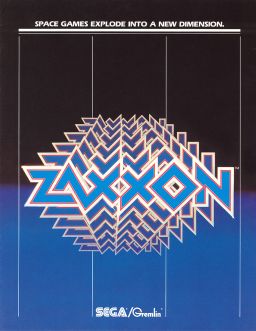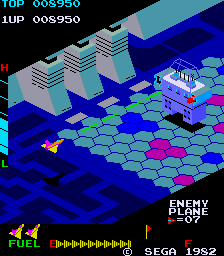Zaxxon facts for kids
Quick facts for kids Zaxxon |
|
|---|---|

North American arcade flyer
|
|
| Developer(s) | Sega Ikegami Tsushinki |
| Publisher(s) |
|
| Series | Zaxxon |
| Platform(s) | Arcade, ColecoVision, Coleco Adam, Commodore 64, MSX, Atari 2600, Atari 8-bit, SG-1000, Apple II, Intellivision, IBM PC, TRS-80, TRS-80 Color Computer, ZX Spectrum |
| Release date(s) |
|
| Genre(s) | Scrolling shooter |
| Mode(s) | 1–2 players alternating turns |
| Arcade system | Sega Zaxxon |
Zaxxon is an exciting scrolling shooter game. It was created by Sega and first came out in arcades in 1982. In the game, you fly a spaceship through dangerous space fortresses. Another company, Ikegami Tsushinki, also helped make the game.
Zaxxon was special because it was the first game to use something called axonometric projection. This fancy term means it made the game look like it had three dimensions. It gave players a cool view from behind their ship. This unique look is where the game got its name, AXXON from AXONometric.
It was also the very first arcade game ever shown in a TV commercial! A big company, Paramount Pictures, made the ad. When Zaxxon was released, people loved it. It became one of the top five most popular arcade games in the United States in 1982. Sega later made a new version called Super Zaxxon and another similar game called Future Spy.
Contents
How to Play Zaxxon
The main goal in Zaxxon is to hit as many targets as you can. You also need to avoid getting shot down. Your ship uses fuel, but you can get more by blowing up fuel drums. Each drum gives you 300 points!
The game has two big fortresses to fly through. There's also a part where you fly in outer space between them. At the end of the second fortress, you face a huge robot boss named Zaxxon.
Flying Your Ship
Your ship has a shadow that helps you see how high you are flying. There's also an altimeter, which is like a height meter. When you are in space, there's nothing for your ship's shadow to fall on.
Each fortress has openings at the start and end. You must fly at the correct height to get through them. Inside the fortresses, there are more walls. Your ship's shadow and altimeter help you fly over these walls safely.
Game Controls
You control your ship with a four-directional joystick. In the arcade version, it looks like an aircraft stick. Pushing the stick forward makes your ship fly lower. Pulling it back makes your ship go higher. Your ship always flies forward at the same speed. It cannot move faster or slower. Because these controls were new, the arcade machines had pictures to show you how to use the joystick.
Zaxxon on Other Systems
Between 1982 and 1985, Zaxxon was released on many different home computers and game consoles. These versions are called "ports." Some of these included the Apple II, Atari 8-bit computers, Atari 2600, Commodore 64, and ColecoVision.
The versions for the Atari 2600 and Intellivision looked a bit different. Instead of the special 3D-like view, they showed the game from directly behind your ship.
Zaxxon's History and Other Games
Zaxxon has been re-released and has had several sequels over the years.
Re-releases
You can find Zaxxon as a bonus game in the Sega Genesis Collection for the PlayStation 2. It's also an unlockable arcade game in Sonic's Ultimate Genesis Collection for the Xbox 360 and PlayStation 3. The original arcade game was also released on the Wii Virtual Console. In 2022, the arcade version was included in the Sega Astro City Mini V, a special mini console.
Sequels and Spin-offs
Zaxxon got an arcade sequel in November 1982 called Super Zaxxon. This game had different colors and your ship flew much faster, making it harder. The space part was replaced with a tunnel. At the end of the second fortress, you fought a dragon instead of a robot! Super Zaxxon was not as popular as the first game.
In 1984, Sega released Future Spy, which had a similar style to Zaxxon.
In 1987, Zaxxon 3-D came out for the Master System. This version used special 3-D glasses to make the game look like it was popping out at you! Like the Atari 2600 and Intellivision versions, it scrolled forward instead of using the isometric view.
Zaxxon's Motherbase 2000 was released for the Sega 32X in 1995. This was the first Zaxxon game to use polygon graphics, which made the objects look more solid and 3D. In Japan, this game was called Parasquad, and in Europe, it was called Motherbase. Many critics in the U.S. felt it wasn't much like the original Zaxxon at all.
Finally, Zaxxon Escape was released on October 4, 2012, for mobile phones and tablets. However, many people felt this game also didn't feel much like the classic Zaxxon.


